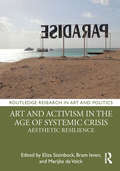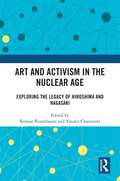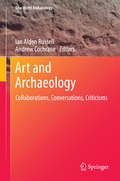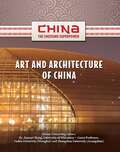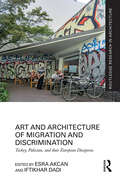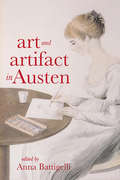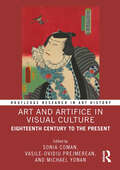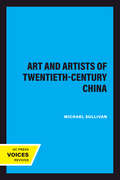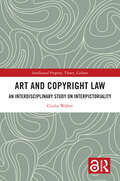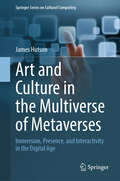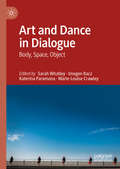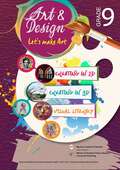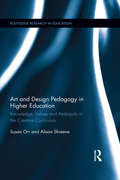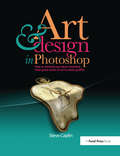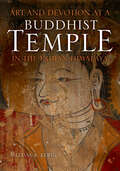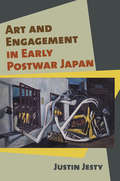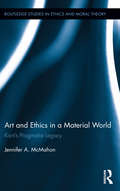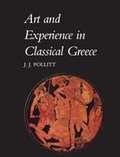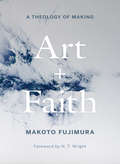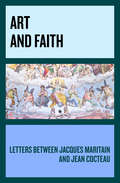- Table View
- List View
Art and Activism in the Age of Systemic Crisis: Aesthetic Resilience (Routledge Research in Art and Politics)
by Marijke De Valck Eliza Steinbock Bram IevenThis book examines how renewed forms of artistic activism were developed in the wake of the neoliberal repression since the 1980s. The volume shows the diverse ways in which artists have sought to confront systemic crises around the globe, searching for new and enduring forms of building communities and reimagining the political horizon. The authors engage in a dialogue with these artistic efforts and their histories – in particular the earlier artistic activism that was developed during the civil rights era in the 1960s and 70s – providing valuable historical insight and new conceptual reflection on the future of aesthetic resilience. This book will be of interest to scholars in contemporary art, history of art, film and literary studies, protest movements, and social movements.
Art and Activism in the Nuclear Age: Exploring the Legacy of Hiroshima and Nagasaki
by Yasuko Claremont Roman RosenbaumThis book explores the contemporary legacy of Hiroshima and Nagasaki following the passage of three quarters of a century, and the role of art and activism in maintaining a critical perspective on the dangers of the nuclear age. It closely interrogates the political and cultural shifts that have accompanied the transition to a nuclearised world. Beginning with the contemporary socio-political and cultural interpretations of the impact and legacy of the destruction of Hiroshima and Nagasaki, the chapters examine the challenges posed by committed opponents in the cultural and activist fields to the ongoing development of nuclear weapons and the expanding industrial uses of nuclear power. It explores how the aphorism that "all art is political" is borne out in the close relation between art and activism. This multi-disciplinary approach to the socio-political and cultural exploration of nuclear energy in relation to Hiroshima/Nagasaki via the arts will be of interest to students and scholars of peace and conflict studies, social political and cultural studies, fine arts, and art and aesthetic studies.
Art and Archaeology of Challuabamba, Ecuador
by Terence GriederChalluabamba (chī-wa-bamba)--now a developing suburb of Cuenca, the principal city in the southern highlands of Ecuador--has been known for a century as an ancient site that produced exceptionally fine pottery in great quantities. Suspecting that Challuabamban ceramics might provide a link between earlier, preceramic culture and later, highly developed Formative period art, Terence Grieder led an archaeological investigation of the site between 1995 and 2001. In this book, he and the team of art historians and archaeologists who excavated at Challuabamba present their findings, which establish the community's importance as a center in a network of trade and artistic influence that extended to the Amazon River basin and the Pacific Coast. Art and Archaeology of Challuabamba, Ecuador presents an extensive analysis of ceramics dating to 2100-1100 BC, along with descriptions of stamps and seals, stone and shell artifacts, burials and their offerings, human remains, and zooarchaeology. Grieder and his coauthors demonstrate that the pottery of Challuabamba fills a gap between early and late Formative styles and also has a definite connection with later highland styles in Peru. They draw on all the material remains to reconstruct the first clear picture of Challuabamba's prehistory, including agriculture and health, interregional contacts and exchange, red-banded incised ware and ceramic production, and shamanism and cosmology. Because southern Ecuador has received relatively little archaeological study, Art and Archaeology of Challuabamba, Ecuador offers important baseline data for what promises to be a key sector of the prehistoric Andean region.
Art and Archaeology: Collaborations, Conversations, Criticisms (One World Archaeology #11)
by Ian Alden Russell Andrew CochraneThis volume presents a collection of interdisciplinary collaborations between contemporary art, heritage, anthropological, and archaeological practitioners. Departing from the proceedings of the Sixth World Archaeological Congress's 'Archaeologies of Art' theme and Ábhar agus Meon exhibitions, it includes papers by seminal figures as well as experimental work by those who are exploring the application of artistic methods and theory to the practice of archaeology. Art and archaeology: collaborations, conversations, criticisms encourages the creative interplay of various approaches to 'art' and 'archaeology' so these new modes of expression can contribute to how we understand the world. Established topics such as cave art, monumental architecture and land art will be discussed alongside contemporary video art, performance art and relational arts practices. Here, the parallel roles of artists as makers of new worlds and archaeologists as makers of pasts worlds are brought together to understand the influences of human creativity.
Art and Architecture of China (China: The Emerging Superpower)
by Shelia Hollihan-ElliotChina has a rich artistic tradition extending back thousands of years. Art and Architecture of China surveys the art treasures of this vibrant civilization, from ancient and imperial China to today's People's Republic. The arts of each era are interpreted in the context of the life, culture, and politics of that era, offering insights to their meaning and showing how China's artistic output has reflected the development of Chinese society and thought. Art forms studied include ancient bronze ritual vessels and jade; the Three Perfections (calligraphy, poetry, and brush painting); ceramics and porcelain; sculpture; decorative and folk art; and modern, Western-influenced painting. Traditional Chinese architecture and town planning is also explored, revealing key technologies and design principles. In addition, today's interplay between traditional architecture and cutting-edge modernism is examined.
Art and Architecture of Migration and Discrimination: Turkey, Pakistan, and their European Diasporas (Routledge Research in Architecture)
by Iftikhar Dadi Esra AkcanThis book brings together essays by established and emerging scholars that discuss Pakistan, Turkey, and their diasporas in Europe. Together, the contributions show the scope of diverse artistic media, including architecture, painting, postcards, film, music, and literature, that has responded to the partitions of the twentieth century and the Muslim diasporas in Europe. Turkey and Pakistan have been subject to two of the largest compulsory population transfers of the twentieth century. They have also been the sites for large magnitudes of emigration during the second half of the twentieth century, creating influential diasporas in European cities such as London and Berlin. Discrimination has been both the cause and result of migration: while internal problems compelled citizens to emigrate from their countries, blatant discriminatory and ideological constructs shaped their experiences in their countries of arrival. Read together, the Partition emerges from the essays in Part I not as a pathology specific to the Balkans, Middle East, or South Asia, but as a central problematic of the new political realities of decolonization and nation formation. The essays in Part II demonstrate the layered histories and multiple migration paths that have shaped the experiences of Berliners and Londoners. This analysis furthers the study of modernism and migration across the borders of, not only the nation-state, but also class, race, and gender. As a result, this book will be of interest to a broad multidisciplinary academic audience including students and faculty, artists, architects and planners, as well as non-specialist general public interested in visual arts, architecture and urban literature.
Art and Artifact in Austen (Victorian Literature and Culture Series)
by Anna BattigelliJane Austen distinguished herself with genius in literature, but she was immersed in all of the arts. Austen loved dancing, played the piano proficiently, meticulously transcribed piano scores, attended concerts and art exhibits, read broadly, wrote poems, sat for portraits by her sister Cassandra, and performed in theatricals. For her, art functioned as a social bond, solidifying her engagement with community and offering order. And yet Austen’s hold on readers’ imaginations owes a debt to the omnipresent threat of disorder that often stems—ironically—from her characters’ socially disruptive artistic sensibilities and skill. Drawing from a wealth of recent historicist and materialist Austen scholarship, this timely work explores Austen’s ironic use of art and artifact to probe selfhood, alienation, isolation, and community in ways that defy simple labels and acknowledge the complexity of Austen’s thought.
Art and Artifice in Visual Culture: Eighteenth Century to the Present (Routledge Research in Art History)
by Michael Yonan Sonia Coman Vasile-Ovidiu PrejmereanThis edited volume explores the notion of “artifice” in modern visual culture, ranging from the eighteenth century to the present, in countries around the globe.Artifice has been regarded as a primarily Western phenomenon, playing as it does a central role in European art theory since the Renaissance. This volume proposes that artifice is better understood as a transcultural artistic phenomenon and requires far broader conceptualization across international contexts. It acquaints readers with works of art, visual modes of communication, and concepts originating in France, Germany, the United States, Japan, and China, and includes painting, sculpture, drawings, prints, photographs, film, and virtual reality/augmented reality (VR/AR) objects. Contributors demonstrate how practices of artifice function as both symbol and form, in parallel and divergent ways, in multiple cultural settings.The book will be of interest to scholars working in art history, visual culture, and material culture.
Art and Artists of Twentieth-Century China
by Michael SullivanThis visually stunning book focuses on the rebirth of Chinese art in the twentieth century under the influence of Western art and culture. Michael Sullivan, recognized throughout the world as a leading scholar of Chinese art, vividly documents the conflicting pulls of traditional and Western values on Chinese art and provides 364 illustrations, in color and black-and-white, to show the great range of artistic expression and the historical processes that occurred within various movements. A substantial biographical index of twentieth-century Chinese artists is a valuable addition to the text.Sullivan discusses artists and their work against China's background of oppression and relaxation, despair and hope. He expertly conveys the diverse and at times bizarre intertwining of Chinese cultural history and art during this century. Included are the intense debates between traditionalists and reformers, the creation of the first art schools, and the birth of the idea—shocking in ethnocentric China—that art is a world language that obliterates all frontiers. The scholarly traditions of classical Chinese painting, the belated discovery of Western modernism, the artistic upheaval under Communism, and China's rethinking of the very nature of art all have a place in Sullivan's fascinating history.Michael Sullivan has known many of the major figures in China's modern art movement of the 1930s and 1940s and has also gained the confidence of younger artists who rose to prominence following the 1979 "Peking Spring." This long-awaited book—richly documented and abundantly illustrated—is a capstone to Sullivan's work and will be enthusiastically welcomed by art lovers everywhere.
Art and Copyright Law: An Interdisciplinary Study on Interpictoriality (Intellectual Property, Theory, Culture)
by Giulia WalterThis book tackles the lack of synchronicity between art and copyright law, proposing practical and interdisciplinary tools through which to navigate this conflict.In the last decades, high profile lawsuits have been filed against artists accused of plagiarism including Jeff Koons, Barbara Kruger and Andy Warhol. This book demonstrates how these cases are at odds with contemporary artistic reality, in which the use of antecedent visual forms is common practice. Focusing on the dichotomies of “original/copy” and of “old/new”, this work addresses this phenomenon from both theoretical and legal perspectives. Using Swiss copyright law as the main case study, the book comparatively assesses other international legal frameworks. Through understanding the origins of the conflict between art and copyright, the book highlights solutions to handle copyright cases with a new methodological approach.The book will be of interest to researchers in the field of art and copyright law, intellectual property and art.The Open Access version of this book, available at http://www.taylorfrancis.com, has been made available under a Creative Commons Attribution-Non Commercial-No Derivatives (CC BY-NC-ND) 4.0 license.
Art and Cosmotechnics (e-flux)
by Yuk HuiIn light of current discourses on AI and robotics, what do the various experiences of art contribute to the rethinking of technology today?Art and Cosmotechnics addresses the challenge of technology to the existence of art and traditional thought, especially in light of current discourses on artificial intelligence and robotics. It carries out an attempt on the cosmotechnics of Chinese landscape painting in order to address this question, and further asks: What is the significance of shanshui (mountain and water) in face of the new challenges brought about by the current technological transformation? Thinking art and cosmotechnics together is an attempt to look into the varieties of experiences of art and to ask what these experiences might contribute to the rethinking of technology today.
Art and Creativity in Reggio Emilia: Exploring the Role and Potential of Ateliers in Early Childhood Education (Contesting Early Childhood)
by Vea VecchiThis book explores the contribution of and art and creativity to early education, and examines the role of the atelier (an arts workshop in a school) and atelierista (an educator with an arts background) in the pioneering pre-schools of Reggio Emilia. It does so through the unique experience of Vea Vecchi, one of the first atelieristas to be appointed in Reggio Emilia in 1970. Part memoir, part conversation and part reflection, the book provides a unique insider perspective on the pedagogical work of this extraordinary local project, which continues to be a source of inspiration to early childhood practitioners and policy makers worldwide. Vea’s writing, full of beautiful examples, draws the reader in as she explains the history of the atelier and the evolving role of the atelierista. Key themes of the book include: • processes of learning and knowledge construction • the theory of the hundred languages of childhood and the role of poetic languages • the importance of organisation, ways of working and tools, in particular pedagogical documentation • the vital contribution of the physical environment • the relationship between the atelier, the atelierista, the school and its teachers This enlightening book is essential reading for students, practitioners, policy makers and researchers in early childhood education, and also for all those in other fields of education interested in the relationship between the arts and learning.
Art and Culture in the Multiverse of Metaverses: Immersion, Presence, and Interactivity in the Digital Age (Springer Series on Cultural Computing)
by James HutsonDrawing on the art historical framing of Location, Place, and Identity, this book will examine how the factors of Immersion, Presence, and Interactivity of XR are shaping our understanding of the world and our place within it. Location refers to the specific geographical or spatial context in which a work of art is created or experienced. Place refers to the social, cultural, and historical context of that location. Identity refers to the ways in which individuals and communities construct and express their sense of self and belonging within those contexts. Through case studies and theoretical analysis, Art and Culture in the Multiverse of Metaverses - Immersion, Presence, and Interactivity in the Digital Age, will explore how the factors of Immersion, Presence, and Interactivity of XR can be aligned with these art historical concepts, providing new opportunities for understanding and engaging with Location, Place, and Identity. For example, XR can be used to create immersive experiences of historical locations and cultural sites, allowing users to explore and engage with them in ways that would otherwise be impossible. Additionally, XR can be used to create interactive artworks that engage with issues of identity and belonging, creating new possibilities for self-expression and exploration.
Art and Culture: Critical Essays
by Clement Greenberg"Clement Greenberg is, internationally, the best-known American art critic popularly considered to be the man who put American vanguard painting and sculpture on the world map. . . . An important book for everyone interested in modern painting and sculpture."--The New York Times
Art and Dance in Dialogue: Body, Space, Object
by Sarah Whatley Imogen Racz Katerina Paramana Marie-Louise CrawleyThis interdisciplinary book brings together essays that consider how the body enacts social and cultural rituals in relation to objects, spaces, and the everyday, and how these are questioned, explored, and problematised through, and translated into dance, art, and performance. The chapters are written by significant artists and scholars and consider practices from various locations, including Central and Western Europe, Mexico, and the United States. The authors build on dialogues between, for example, philosophy and museum studies, and memory studies and post-humanism, and engage with a wide range of theory from phenomenology to relational aesthetics to New Materialism. Thus this book represents a unique collection that together considers the continuum between everyday and cultural life, and how rituals and memories are inscribed onto our being. It will be of interest to scholars and practitioners, students and teachers, and particularly those who are curious about the intersections between arts disciplines.
Art and Design - Let’s Make Art class 9 - MIE
by Mauritius Institute of EducationDiscover the vibrant world of visual arts with 'Creating in 2D: Exploring Media, Composition, Perspective, Color, Painting Techniques, and Figure Drawing.' This comprehensive textbook delves into diverse artistic realms, from mastering color schemes and three-point perspective to honing figure drawing skills. Students will embark on a journey through RecycloEnviro Arts, learning sustainable techniques like tie and dye and batik, while also delving into graphic design fundamentals, encompassing decorative writing, logo design, and landscape patterns through simple ICT software. With a special focus on street art in Mauritius, the textbook highlights local initiatives and murals, fostering an appreciation for art's role in cultural expression and community engagement. Whether aspiring artists or seasoned creatives, learners will find inspiration and practical guidance to unleash their creativity in the dynamic world of 2D art.
Art and Design Pedagogy in Higher Education: Knowledge, Values and Ambiguity in the Creative Curriculum (Routledge Research in Higher Education)
by Susan Orr Alison ShreeveArt and Design Pedagogy in Higher Education provides a contemporary volume that offers a scholarly perspective on tertiary level art and design education. Providing a theoretical lens to examine studio education, the authors suggest a student-centred model of curriculum that supports the development of creativity. The text offers readers analytical frameworks with which to challenge assumptions about the art and design curriculum in higher education. In this volume, Orr and Shreeve critically interrogate the landscape of art and design higher education, offering illuminating viewpoints on pedagogy and assessment. New scholarship is introduced in three key areas: curriculum: the nature and purpose of the creative curriculum and the concept of a ‘sticky curriculum’ that is actively shaped by lecturers, technicians and students; ambiguity, which the authors claim is at the heart of a creative education; value, asking what and whose ideas, practices and approaches are given value and create value within the curriculum. These insights from the perspective of a creative university subject area also offer new ways of viewing other disciplines, and provide a response to a growing educational interest in cross-curricular creativity. This book offers a coherent theory of art and design teaching and learning that will be of great interest to those working in and studying higher education practice and policy, as well as academics and researchers interested in creative education.
Art and Design in Photoshop: How To Simulate Just About Anything From Great Works Of Art To Urban Graffiti
by Steve CaplinFancy designing your own classic and contemporary movie posters, books and magazine covers?Feel like turning your photographs into works by Turner, Matisse and Magritte?Want to create illustrations in the styles of The Simpsons, steampunk and Victorian engravings?Then you need Art and Design in Photoshop. In this unique book, acclaimed master of photomontage and visual trickery Steve Caplin shows you how to stretch your creative boundaries. Taking the same tried-and-tested practical approach as his best selling How to Cheat in Photoshop titles, Steve's step-by-step instructions recreate a dazzling and diverse array of fabulous design effects. You'll learn how to design everything from wine labels to sushi cartons, from certificates to iPod advertising, from textbooks to pulp fiction.Written by a working pro, the clear guidelines pinpoint exactly what you need to know: how to get slick-looking results with minimum fuss, with a 16-page Photoshop Reference chapter that provides an at-a-glance guide to Photoshop tools and techniques for less experienced users. Steve explains both typography and the design process in a clear, informative and entertaining way.All the images, textures and fonts used in the book are supplied on the downloadable resources. Imaginative, inspirational and fun to use, this book is a must-have for every creative Photoshop user, both amateur and professional.
Art and Devotion at a Buddhist Temple in the Indian Himalaya (Contemporary Indian Studies)
by Melissa R. KerinA study of a set of sixteenth-century wall paintings at the Gyapagpa Temple in Nako, a village in India’s Himachal Pradesh state.Sixteenth-century wall paintings in a Buddhist temple in the Tibetan cultural zone of northwest India are the focus of this innovative and richly illustrated study. Initially shaped by one set of religious beliefs, the paintings have since been reinterpreted and retraced by a later Buddhist community, subsumed within its religious framework and communal memory. Melissa Kerin traces the devotional, political, and artistic histories that have influenced the paintings’ production and reception over the centuries of their use. Her interdisciplinary approach combines art historical methods with inscriptional translation, ethnographic documentation, and theoretical inquiry to understand religious images in context.“A meticulous and discerning piece of scholarship, one that is skillful in employing multiple methods—visual, linguistic and ethnographic—to create a fuller picture of a region we knew little about. . . . [A] pleasure to read.” —Pika Ghosh, author of Making Kantha, Making Home: Women at Work in Colonial Bengal“Emphasizing the visual as primary evidence in the study of history, especially religious history, Kerin moves Buddhist art from the arena of museum displays, art markets, and aesthetics to the arena of dynamic interdisciplinary discourse, thus reaffirming the significance of in situ study. . . . Recommended.” —Choice“A forceful study on the specificity of Gyapagpa’s painting.” —South Asia Research/DESC>Indian art;south asian art;religious art;buddhist art;Indian history;south asian history;tibetan buddhism;buddhism;religion;indian buddhists;temple art;nako;gyapagpa;social history;political history;painting style;painting traditionART019020 ART / Asian / Indian & South AsianART035000 ART / Subjects & Themes / ReligiousHIS062000 HISTORY / Asia / South / India *REL007050 RELIGION / Buddhism / Tibetan9780253010032Patterns of War—World War IILarry H. Addington
Art and Engagement in Early Postwar Japan
by Justin JestyJustin Jesty’s Art and Engagement in Early Postwar Japan reframes the history of art and its politics in Japan post-1945. This fascinating cultural history addresses our broad understanding of the immediate postwar era moving toward the Cold War and subsequent consolidations of political and cultural life. At the same time, Jesty delves into an examination of the relationship between art and politics that approaches art as a mode of intervention, but he moves beyond the idea that the artwork or artist unilaterally authors political significance to trace how creations and expressive acts may (or may not) actually engage the terms of shared meaning and value.Art and Engagement in Early Postwar Japan centers on a group of social realists on the radical left who hoped to wed their art with anti-capitalist and anti-war activism, a liberal art education movement whose focus on the child inspired innovation in documentary film, and a regional avant-garde group split between ambition and local loyalty. In each case, Jesty examines writings and artworks, together with the social movements they were a part of, to demonstrate how art—or more broadly, creative expression—became a medium for collectivity and social engagement. He reveals a shared if varied aspiration to create a culture founded in amateur-professional interaction, expanded access to the tools of public authorship, and dispersed and participatory cultural forms that intersected easily with progressive movements. Highlighting the transformational nature of the early postwar, Jesty deftly contrasts it with the relative stasis, consolidation, and homogenization of the 1960s.
Art and Ethics in a Material World: Kant’s Pragmatist Legacy (Routledge Studies in Ethics and Moral Theory)
by Jennifer A McMahonIn this book, McMahon argues that a reading of Kant’s body of work in the light of a pragmatist theory of meaning and language (which arguably is a Kantian legacy) leads one to put community reception ahead of individual reception in the order of aesthetic relations. A core premise of the book is that neo-pragmatism draws attention to an otherwise overlooked aspect of Kant’s "Critique of Aesthetic Judgment," and this is the conception of community which it sets forth. While offering an interpretation of Kant’s aesthetic theory, the book focuses on the implications of Kant’s third critique for contemporary art. McMahon draws upon Kant and his legacy in pragmatist theories of meaning and language to argue that aesthetic judgment is a version of moral judgment: a way to cultivate attitudes conducive to community, which plays a pivotal role in the evolution of language, meaning, and knowledge.
Art and Experience in Classical Greece
by J. J. PollittProfessor Pollitt reminds us that the visual arts in Greece, as elsewhere, were primarily vehicles of expression. He does not ignore formal development but always relates this to social and cultural history, which it reflected and from which it grew. While his subject is art, he refers frequently to the literature and philosophy of the period which were shaped by the same influences.
Art and Faith: A Theology of Making
by Makoto FujimuraFrom a world-renowned painter, an exploration of creativity&’s quintessential—and often overlooked—role in the spiritual life "Makoto Fujimura is the rare artist whose life has something of the same purifying and galvanizing force of his work. His new book brings those two elements—life and art—even closer together, and is a real tonic for our atomized time." —Christian Wiman Conceived over thirty years of painting and creating in his studio, this book is Makoto Fujimura&’s broad and deep exploration of creativity and the spiritual aspects of &“making.&” What he does in the studio is theological work as much as it is aesthetic work. In between pouring precious, pulverized minerals onto handmade paper to create the prismatic, refractive surfaces of his art, he comes into the quiet space in the studio, in a discipline of awareness, waiting, prayer, and praise. Ranging from the Bible to T. S. Eliot, and from Mark Rothko to Japanese Kintsugi technique, he shows how unless we are making something, we cannot know the depth of God&’s being and God&’s grace permeating our lives. This poignant and beautiful book offers the perspective of, in Christian Wiman&’s words, &“an accidental theologian,&” one who comes to spiritual questions always through the prism of art.
Art and Faith: Letters between Jacques Maritain and Jean Cocteau
by Jean Cocteau Jacques MaritainThe meaning of poetry and the sociological and political significance of art are dealt with in these letters.
Art and Faith: Letters between Jacques Maritain and Jean Cocteau
by Jean Cocteau Jacques MaritainThe meaning of poetry and the sociological and political significance of art are dealt with in these letters.
